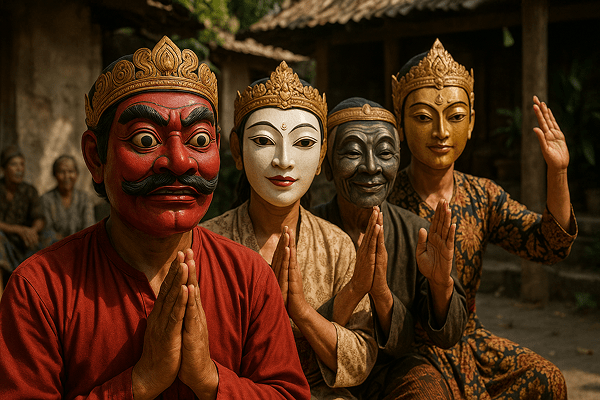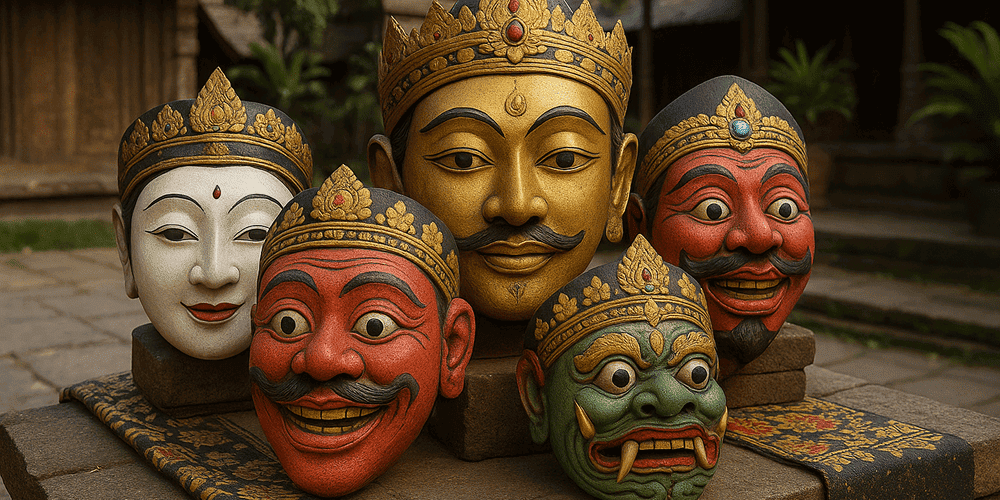Javanese Masks, known locally as “Topeng Jawa,” are an integral part of Indonesia’s rich artistic and spiritual tradition. These masks are most prominent in the cultural heartland of Java, particularly in Central and East Java, and play a vital role in classical dance-drama performances known as Topeng. Javanese Masks are instantly recognizable for their delicate craftsmanship, expressive features, and vibrant colors. Typically, they display refined facial expressions, detailed carvings, and are adorned with symbolic motifs such as floral patterns or geometric shapes. The tradition of Javanese Mask-making can be traced back over a thousand years, making these masks a living testament to Java’s enduring artistic legacy.
Historical Origins: The Story Behind Javanese Masks
The history of Javanese Masks dates back to the ancient Hindu-Buddhist kingdoms of Java, such as Majapahit and Kediri, around the 10th to 15th centuries CE. The term “Topeng” literally means “mask” in Javanese and Indonesian, reflecting the centrality of the mask in local performance and ritual. Early evidence of mask use is found in temple reliefs and ancient manuscripts, where masks were associated with religious ceremonies, storytelling, and royal court entertainment. Over time, the design and function of Javanese Masks evolved, influenced by Islamic culture, colonial contact, and local folklore. The Topeng tradition itself adapted to societal changes, blending myth, history, and social commentary. Archaeological finds, ancient scripts, and preserved masks in museum collections provide valuable insights into their development. The story of Javanese Masks is closely connected to other Indonesian mask traditions, such as the dramatic Rangda Masks of Bali, which share a focus on spiritual transformation and performance.
Cultural Significance and Symbolism: The Meaning of Javanese Masks
Javanese Masks hold deep cultural and symbolic value. Each mask represents a specific character from traditional stories, legends, or epics, such as the Ramayana or Mahabharata. The masks embody archetypal figures — heroes, villains, clowns, and noble kings — each with distinct facial expressions and color codes. Red often symbolizes courage or passion, white signifies purity, black represents wisdom or age, and gold is associated with divinity or royalty. In spiritual contexts, the act of donning a mask is believed to invoke the presence of ancestral spirits or deities, allowing performers to channel their power and wisdom. Socially, Topeng performances are a communal event, uniting villagers through dance, music, and storytelling. Javanese Masks also serve as a means for social critique, using satire and comedy to address contemporary issues.

Materials and Craftsmanship: Creating Javanese Masks
Traditional Javanese Masks are crafted from lightweight wood — often pule or waru — selected for its fine grain and ease of carving. The process begins with the careful shaping of the mask’s form, followed by intricate carving to define facial features and decorative details. Artisans use chisels, knives, and natural pigments to achieve smooth surfaces and vibrant colors. After carving, the mask is sanded, painted, and sometimes gilded or inlaid with shells, beads, or gold leaf. Regional workshops may introduce unique techniques, such as batik-style painting or lacquer finishing. The color symbolism and decorative motifs are chosen not only for aesthetic appeal but also to reflect the character’s personality and role in the performance. Each mask is a unique work of art, often taking days or even weeks to complete.
Functions and Use: Javanese Masks in Ritual and Performance
Javanese Masks are primarily used in Topeng dance-drama, where dancers embody legendary and historical characters, telling stories of love, war, and morality. These performances are central to temple festivals, royal ceremonies, and village celebrations. In ritual contexts, masks are worn during exorcisms, harvest rites, or ancestral worship, believed to channel protective or healing spirits. Over time, the use of Javanese Masks has expanded to include modern theatre, educational outreach, and cultural tourism. Today, Topeng performances remain popular across Java and are showcased internationally, keeping the tradition alive for new generations.
Regional Variations: Diversity of Javanese Masks Across Java
There is significant regional diversity in Javanese Mask traditions. In Central Java, masks are often more delicate and naturalistic, reflecting the refined court culture of Yogyakarta and Surakarta. East Javanese masks tend to be bolder, with exaggerated features and vibrant colors, echoing local legends and folk tales. Some regions, like Cirebon on the north coast, have developed their own distinct Topeng traditions, known for their eclectic styles and innovative choreography. Each village or workshop may have its own set of characters and design conventions, making the world of Javanese Masks rich in local color and creativity. When compared to Balinese Rangda Masks, Javanese Masks are generally more restrained and focus on narrative rather than supernatural drama.
Famous Examples and Collections: Where to See Javanese Masks
Notable collections of Javanese Masks can be found in museums such as the National Museum of Indonesia (Jakarta), the Ullen Sentalu Museum (Yogyakarta), and the Museum Topeng (Malang). These institutions showcase masks from various regions and historical periods, alongside costumes, musical instruments, and performance records. Archaeological finds, ancient carvings, and royal collections provide further insight into the history of Topeng in Java. Private collectors and online galleries, including toddmasks.com, offer curated selections and educational resources for enthusiasts and scholars.

Influence on Art and Culture: Javanese Masks in Modern Creativity
Javanese Masks have had a significant impact on Indonesian visual arts, literature, music, and contemporary theatre. Their elegant forms and symbolic meanings inspire painters, sculptors, and fashion designers in Indonesia and beyond. In popular culture, Topeng motifs appear in films, novels, and music, often representing themes of transformation, duality, and social commentary. The preservation and performance of Topeng help maintain a sense of cultural identity and continuity, while also encouraging innovation and cross-cultural exchange. Javanese Masks play a crucial role in promoting and preserving Indonesia’s artistic heritage.
Modern Status and Preservation: The Tradition of Javanese Masks Today
The tradition of Javanese Mask-making and performance is upheld by master artisans, dance troupes, and cultural institutions across Java. Workshops and apprenticeships pass on carving and painting techniques to new generations. Modern adaptations include collaborations with international artists, fusion with contemporary dance, and the use of digital media. Educational programs, festivals, and museum exhibitions support the appreciation and revitalization of the Topeng tradition. Government and private initiatives aid in the documentation and safeguarding of this unique cultural asset.
Collecting and Acquisition: The Market for Javanese Masks
The market for Javanese Masks includes both antique and contemporary examples, available from museum shops, art galleries, and online platforms such as toddmasks.com. Prices vary according to age, rarity, craftsmanship, and provenance. Collectors are advised to seek authenticity documentation, understand the cultural context, and support ethical practices that benefit artisan communities. By collecting and displaying Javanese Masks responsibly, individuals help sustain the living tradition and promote respect for Indonesian culture.
